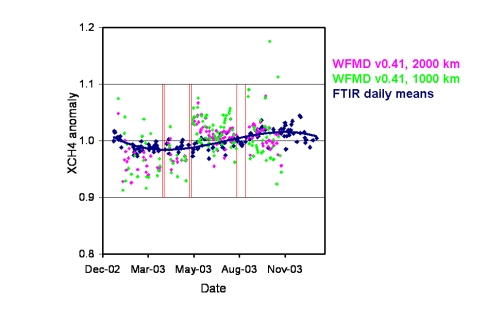Results: First Ground-Based Validation of Global Satellite-Based Columnar Methane Data
The atmospheric trace species methane (CH4) contributes by 15% to the anthropogenic greenhouse forcing, and has recently been included into the list of the so called "Kyoto gases". It has thus become mandatory to better understand and monitor its spatiotemporal distribution on a global and centennial scale. In particular, the locations and strengths of the CH4 sources are not sufficiently quantified yet (IPCC, 2007). An obstacle for the quantification of surface sources is that measurements of small variations on top of a large background of this well-mixed gas are required. Therefore, measurements with both high precision and global coverage are needed.
Satellite-borne remote sounders are providing total columns and have the potential to add the required information on the global distribution of CH4 to the highly precise ground-based networks, but strongly rely upon careful ground-truthing.
Therefore, methane total-vertical column retrievals from ground-based solar FTIR measurements at the Permanent Ground-Truthing Station Zugspitze (47.42 °N, 10.98 °E, 2964 m asl.), Germany were used in 2005 to validate column averaged methane retrieved from ENVISAT/SCIAMACHY spectra by WFM-DOAS (WFMD) version 0.4 and 0.41 for 153 days in 2003. Smoothing errors were estimated to be below 0.10 % for FTIR and 0.14 % for SCIAMACHY-WFMD retrievals and could be neglected for the assessment of observed bias and day-to-day-scatter. In order to minimize the altitude-difference effect, dry-air column averaged mixing ratios (XCH4) have been utilized. From the FTIR-time series of XCH4 an atmospheric day-to-day variability of 1 % was found, and a sinusoidal annual cycle with a ≈1.6 % amplitude.

To obtain the WFMD bias, a polynomial fitted to the FTIR series was used as a reference. The result is WFMD v0.4 / FTIR = 1.008 ± 0.019 and WFMD v0.41 / FTIR = 1.058 ± 0.008. WFMD v0.41 was significantly improved by a time-dependent bias correction. I can still not capture the natural day-to-day variability, i.e., the standard deviation calculated from the daily-mean values is 2.4 % using averages within a 2000-km radius, and 2.7 % for a 1000-km radius. These numbers are dominated by a residual time-dependent bias in the order of 3 % / month (due to detector icing in channel 8). The latter can be reduced, e.g., from 2.4 % to 1.6 % as shown by an empirical time-dependent bias correction. Standard deviations of the daily means, calculated from the individual measurements of each day, are excluding time-dependent biases, thus showing the potential precision of WFMD daily means, i.e., 0.3 % for a 2000-km selection radius, and 0.6 % for a 1000-km selection radius, for the case that the time dependent bias would could be eliminated. Therefore, the natural variability could be captured under the prerequisite of further advanced time-dependent bias corrections, or the use of other channels, where the icing issue is less prominent.
References
Sussmann, R., Stremme, W. Buchwitz, M., and de Beek, R.: Validation of ENVISAT/SCIAMACHY columnar methane by solar FTIR spectrometry at the Ground-Truthing Station Zugspitze, Atmos. Chem. Phys., 5, 2419–2429, 2005 ![]() .
.
An updated study of newest version ENVISAT/SCIAMACHY methane retrievals (not impacted from detector icing) is currently under way [Sussmann et al., to be published].
Related papers
Sussmann, R. and Buchwitz, M.: Initial validation of ENVISAT/SCIAMACHY columnar CO by FTIR profile retrievals at the Ground-Truthing Station Zugspitze, Atmos. Chem. Phys., 5, 1497–1503, 2005 ![]() .
.
Sussmann, R., Stremme, W., Burrows, J.P., Richter, A., Seiler, W., and Rettinger, M.: Stratospheric and tropospheric NO2 variability on the diurnal and annual scale: a combined retrieval from ENVISAT/SCIAMACHY and solar FTIR at the Permanent Ground-Truthing Facility Zugspitze/Garmisch, Atmos. Chem. Phys., 5, 2657–2677, 2005 ![]() .
.
